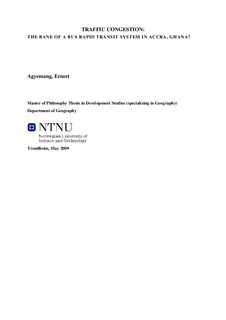| dc.description.abstract | The role of transportation to urban dwellers cannot be overemphasised. Transportation enables employment, education, health services and leisure. Indeed, it ensures proper “urban insertion” (Wane, 2001, p.1). However, owing to high levels of motorization, in recent times, inadequate traffic management strategies, as well as inadequate land use and transportation planning, traffic congestion is not uncommon in cities all over the world. The economic, social, environmental and safety costs of traffic congestion are numerous and have gained much attention in the existing literature. This study proceeds with the aim of identifying the causes and the extent to which traffic congestion in the Ghanaian capital city of Accra, conspired with other factors to collapse a pilot Bus Rapid Transit System which was introduced to curb traffic congestion in the city once and for all.
With the use of the triangulation approach, research tools belonging to both the quantitative and qualitative methods of doing research, such the GIS-based techniques; five key informant in-depth interviews; three semi-structured interviews; a focus group discussion and participatory observation, in addition to using the Time-Geographic framework, the Structuration and General Systems theories respectively as interpretative guides, this study made interesting findings.
Improper land use practises, poor siting of terminals and transit points regardless of planning and architectural principles, activities of the informal economy and the woefully inadequate transport infrastructure were identified as the factors that cause traffic congestion on the Kimbu-Adenta highway on which the pilot BRTS operated. While traffic congestion made it impossible to operate scheduled bus services and increased the operational costs of the pilot project, other factors such as unhealthy competition among transport operators in Accra, the absence of a supporting legislative instrument, internal human lapses and the lack of public education were also identified as having contributed to the demise of the pilot BRTS.
Proposals to reduce traffic congestion such as improving transport infrastructure, congestion pricing, enhancing accidents management mechanisms and the implementation of the comprehensive Urban Transport Project (UTP) would not only mitigate traffic congestion but will improve the overall performance of public transportation provision in the city and ensure the success of a future BRTS in Ghana. | nb_NO |
